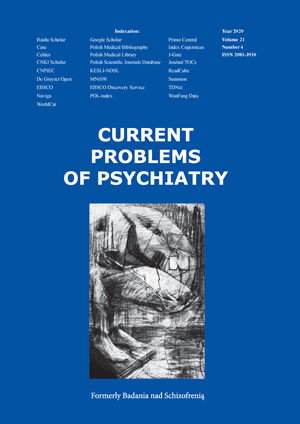White space interpretation in Hermann Rorschach’s inkblot test
DOI:
https://doi.org/10.2478/cpp-2020-0021Keywords:
S responses (space responses), psychological meaning, cultural meaning, high number of S responses, low number of S responsesAbstract
Introduction: The interpretation of white space in the Rorschach test has not been clearly defined. The aim of my research was to analyze the psychological meanings that can be associated with using space in Rorschach test responses. I examined a sample of healthy individuals in order to establish the basic meanings that could serve as points of reference when interpreting ill people’s responses.
Material and method: I personally examined 158 healthy subjects with the Rorschach test. The examination procedure and the way of coding and interpreting responses were based on John Exner’s Comprehensive System. I divided the sample into three groups: I (no S responses), II (one or two S responses), and III (three or more S responses). Next, I distinguished subgroup V (four or more S responses). I analyzed the differences between the groups in terms of other variables obtained in the examination using the Rorschach test. These variables were associated with using the complexity of the presented stimuli and with organizing the stimulus field; they were also associated with the emotional sphere, social adjustment, and ways of coping with stress.
Results: Group III differed from groups II and I in terms of nine variables, and differences regarding further four variables approached significance. Differences between group V and the remaining examinees were more marked and concerned 14 variables.
Discussion: Examinees with more S responses were better at using the complexity of stimuli and organizing the stimulus field. A certain characteristic feature of their emotional sphere also manifested itself: these people experienced situational stress more strongly, colored their responses with aggression, and more frequently experienced loneliness and alienation; intellectualization turned out to be their typical defense mechanism.
Conclusions: Based on the collected material, it can be concluded that responses are related to examinees’ creative potential. Collected from healthy individuals, the material may facilitate the interpretation of ill people’s responses, especially as such research has not been conducted in a Polish population before.
References
1. Exner JE. The Rorschach. A comprehensive system. Haboken, NJ: John Wiley & Sons; 2003.
2. Piotrowski Z. Perceptanalysis. New York, Philadelphia: Exlibris; 1979.
3. Grzywak-Kaczyńska M. Metoda Rorschacha. Warsaw: PZWL; 1967.
4. Smith BL. Object relations theory and the integration of empirical and psychoanalytic approaches to Rorschach interpretation. Rorschachiana. 1994; 19: 61-77.
5. Fonda ChP. The white-space response. In: Rickers-Ovsiankina MA, editor, Rorschach Psychology. Huntington, NY: Robert E. Krieger Publishing Company; 1977. p. 113-156.
6. Rosso AM., Chiorri C, Denevi S. Rorschach space responses and anger. Psychological Reports: Measures & Statistics. 2015; 1: 117–132.
7. Mihura JL, Meyer GJ, Dumitrascu N. The validity of individual Rorschach variables: systematic reviews and meta-analyses of the Comprehensive System. Psychological Bulletin. 2013; 139: 548–605.
8. Last U. Defying the odds and Rorschach space responses: an empirical contribution. Rorschachiana. 2002; 25: 155–162.
9. Czeredecka A. The Rorschach test according to the Exner system as a diagnostic tool in psychological expert opinions. Problems of Forensic Sciences. 2013, 93: 351–370.
10. Carlison RW, Drehmer DE. Rorschach space response and aggression. Perceptual and Motor Skills. 1984, 58: 987–988
11. Schaie KW, Heiss R. Color and personality: a manual for the color pyramid test. Bern, Stuttgart; Hans Huber Publisher: 1964.
12. Dobrzyńska T. Mówiąc przenośnie… Studia o metaforze. Warsaw: Instytut Badań Literackich; 1994.
13. Kalnická Z. Woda. In: Wilkoszewska K, editor. Estetyka czterech żywiołów: ziemia, woda, ogień, powietrze. Kraków: Universitas; 2002. p. 73–130.
14. Bakke M. Przeciw pustce − sztuka pamiętająca materialność powietrza. In: Wilkoszewska K, editor. Czas przestrzeni. Kraków: Universitas; 2002. p. 293–300.
15. Michalski K. Gadamer. In: Gadamer HG. Rozum, słowo, dzieje. Trans. by Małgorzata Łukasiewicz, Krzysztof Michalski. Warsaw: PIW; 2000. p.5-19.
16. Żyłko B. Przedmowa. In: Lotman J. Universum umysłu. Żyłko. Gdańsk: Wydawnictwo Universytetu Gdańskiego: 2008. p .9-65.
17. Buczyńska-Garewicz H. Słowo wstępne: semiotyka i filozofia znaku. In: Bense M. Świat przez pryzmat znaku. Trans. by Jan Garewicz. Warsaw: PIW; 1980. p. 5–38.
18. Burzyńska A. Semiotyka. In: Burzyńska A, Markowski MP, editors. Teoria literatury XX wieku. Podręcznik. Kraków: Wydawnictwo Znak; 2009. p. 231–278.
19. Kalaga W. Mgławice dyskursu. Kraków: Universitas; 2001.
20. Hunca-Bednarska A. Nieco inaczej o teście plam atramentowych Hermanna Rorschacha. Eseje. Lublin; Wydawnictwo KUL: 2013.
21. Hunca-Bednarska A. Test Rorschacha jako metoda ukazująca ludzkie doświadczanie świata. Źródła atrakcyjności plam atramentowych. W:Zasępa E.red. Doświadczenia człowieka w zdrowiu i w chorobie. Warszawa; Wydawnictwo Difin SA ( w druku).
22. Grzywak-Kaczyńska M. Podręcznik do metody Rorschacha. 3rd ed. Edited by Maria Braun-Gałkowska. Lublin: Wydawnictwo KUL; 2006.
23. Choca JP., Rossini ED. Assessment Using the Rorschach Inkblot Test. Washington; American Psychological Association: 2018.
24. Stasiakiewicz M. Test Rorschacha. Warszawa; Wydawnictwo naukowe Scholar: 2003.
Downloads
Published
Issue
Section
License
Copyright (c) 2020 Authors

This work is licensed under a Creative Commons Attribution 4.0 International License.


